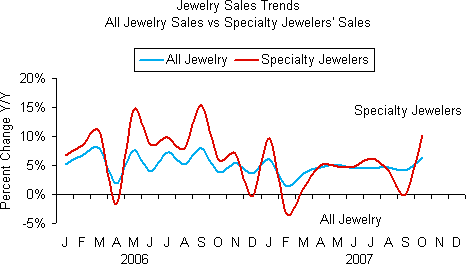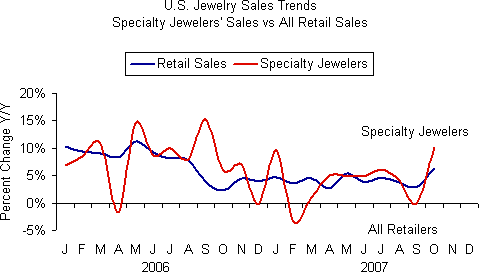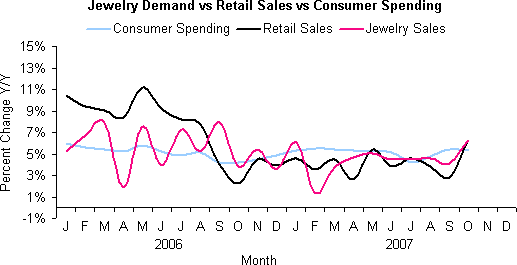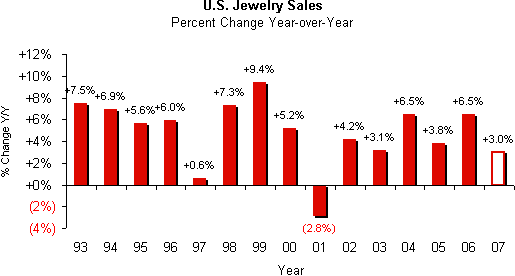IDEX Online Research: U.S. Jewelry Sales Up Sharply in October
December 24, 07
American’s demand for jewelry jumped sharply in October. This is in stark contrast to demand in September, when jewelry sales were up very modestly versus the same period last year. Further, October was a banner month for specialty jewelers: their sales jumped by more than 10 percent over the same period a year ago, according to preliminary numbers from the U.S. Department of Commerce.
The dramatic rise in October jewelry purchases was reflected by some, but not all specialty jewelers in the U.S. Some merchants said that their sales rose solidly in October, after a “terrible” September; other merchants said September’s weak trends continued into October.
- Total Jewelry Sales +6.3% – Total U.S. jewelry sales in the U.S. market during October were up about 6.3 percent over the same month a year ago. This was by far the largest monthly gain in 2007. Further, it matched the gain in total retail sales of +6.3 percent for all goods. By contrast, September jewelry sales were up a more modest 4.1 percent (revised data), while total retail sales were up 2.8 percent.
Despite several negative factors pressuring consumers’ pocketbooks – mortgage woes, higher gasoline prices, a softening economy, and modest wage gains – shoppers once again proved the old adage: When the going gets tough, the tough go shopping. Americans invented recreational shopping, and there is nothing like a trip to the mall to relieve the stresses in the rest of their life. - Specialty Jewelers’ Sales +10.2% – U.S. specialty jewelers posted a whopping 10.2 percent sales gain in October, after suffering through flat sales in September. IDEX Online uses seasonally unadjusted numbers to calculate sales trends, since it reflects “dollars through the cash register” and most closely relates to jewelers’ monthly sales numbers. As a result, we believe that October’s jump in sales actually reflects some delayed demand from September rather than a real change in consumer attitudes towards shopping and buying jewelry.
On a trailing twelve-month basis, specialty jewelers’ sales in the U.S. market are up about 3.7 percent.
|
|
On a year-to-date basis, total U.S. jewelry sales are up by about 4.5 percent, while specialty jewelers’ sales are up by about 4.2 percent. This reflects trends of prior periods which indicate that specialty jewelers continue to lose market share to discounters, mass market merchants, and other retailers whose primary business is not jewelry.
A Wary Outlook
Despite a sharp rebound in jewelry demand by shoppers in October, our jewelry sales forecast for 2007 remains cautious. Last month, we reduced our annual forecast to a 3 percent sales gain. We are leaving that forecast unchanged. November jewelry sales were soft – Kay said its same-store sales from the beginning of November through the Thanksgiving weekend were down 7 percent. Other mass market jewelers apparently have reported worse results. Guild jewelry seems to be the only bright spot: sales gains among upper end jewelers remain relatively solid.
October Jewelry Sales Jump
After significant weakness in September, jewelry sales in the U.S. market rebounded sharply in October. While there were no major calendar events driving demand in either month, it appears that some demand from September shifted to October.
The graph below compares specialty jewelers’ sales trends to total jewelry sales trends in the U.S. market. As the graph clearly illustrates, jewelry demand has been on a roller coaster ride for the past couple of months.
| |
Specialty Jewelers’ Sales Leap Past Retail Gains
During October, specialty jewelers posted a dramatic sales gain of 10.2 percent, based on preliminary data. While it is highly likely that this gain will be revised downward, it is unlikely that we will see a notable different in the trend – demand surged in October, no matter how you measure it.
In contrast, total retail sales were up 6.3 percent, a large gain, but quite modest compared to the sales gain posted by specialty jewelers in America. Total spending by consumers on all goods and services was up by about 5.3 percent in October. Thus, retail demand – and jewelry demand – helped fuel economic growth during the month.
The graph below summarizes sales trends for all retail goods (excluding food and automobiles) versus specialty jewelers’ sales. Why do we eliminate “automobile” sales? Monthly auto sales are driven largely by consumer incentives rather than by underlying economic factors. Over the long term, auto demand trends are an important indicator of consumer vitality; however, on a month-to-month basis, auto demand is dependent on manufacturers’ incentives such as zero percent financing, cash-back offers and other deals.
| |
Consumer Spending Perks Up
Driven by retail demand as well as price inflation of core commodities such as gasoline, October consumer spending trends showed a small uptick over the average gain for the year. Consumer spending was up about 5.3 percent in October, versus the year-to-date average gain of about 5.2 percent. Retail sales were the primary driver of this spending increase; spending on services held about steady during the month.
The graph below summarizes trends in American’s total spending (blue line), retail sales of all goods (black line) and expenditures on jewelry (red line).
|
|
Outlook: Our Forecast Remains Cautious
While October jewelry demand appeared to be strong, reports from various jewelers indicate that November was very weak, and December jewelry demand is extremely soft.
IDEX Online Research recently compared prices of key jewelry items in mass market jewelers’ flyers with retail prices of key consumer electronics products in flyers published by Circuit City and Best Buy. The consumer electronics retailers are targeting their goods in the $300-to-$600 price range; that’s the heart of jewelers’ offerings to mass market consumers. Given a choice between an “exciting diamond pendant” and a “snazzy GPS unit,” apparently most consumers are opting for the latest electronic gadgetry.
Our forecast for jewelry sales in the U.S. market remains at +3 percent for the year ending December 2007. Our greatest concern is that this may prove to be too optimistic.
|
|




